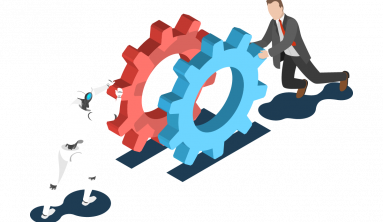App-based training and communication platforms are changing the retail industry, but rollouts aren’t always easy.
The world’s gone mobile, and so have innovative learning, content and performance management systems. If you’re like most retail operations executives, the perceived time and effort of moving enterprise software to the table, and encouraging employees to adopt it, may be daunting.
Stakeholder adoption is key to any new software rollout, especially one introducing a new touchpoint, such as the tablet, for user interaction.
When the new roll-out delivers new enterprise-wise training and communications focused on key brand and customer-driven strategies, its adoption must be vigilantly planned and executed. End users’ personal, social, psychological and motivational needs must govern the roll-out from discovery through to life cycle maturity to assure the deep-rooted adoption that brings customer-centric software goals to life. Retail organizations must completely rethink the adoption phase of today’s fluid, curated retail learning, content and performance management systems.
Traditionally a finite event, yesterday’s software adoption process needs to transform to an ongoing, consistent pursuit that discovers, initiates and continually stimulates a successful, customizable and well-received implementation.
Adoption remains a challenge
Enterprise training software adoption is a multifaceted challenge presenting a variety of obstacles. First of all, the scale and cost of creating enterprise software typically requires broad functionality to make the product marketable.Unfortunately, employees at every level typically resist the change that such functionality requires.
In addition, enterprise-wide end users typically won’t embrace a “one size fit all” solution. Their workflow needs differ greatly from one person, department and store environment to the next. To secure end user adoption, the enterprise software must address this challenge with the flexible customization and content curation that generate a tailored, influential and engaging implementation.
And often, the retail C-suite unwittingly blocks user adoption of innovative enterprise training software by delaying or minimizing its investment. Many leaders champion only those roll-outs delivering immediate ROI, such as operational cost savings. In doing so, they overlook the long-term ROI benefits such as unified associate, brand and corporate goals that deliver on the consumer-driven retail promise.
Progressive retail executives must now embrace new ROI nuances, as well as the mobile, cloud and smart computing tools that generate them. C-level support of systems users go a long way to excite associates and spur adoption.
“How do you expect all of your employees to get on board if your executives and higher-level employees are not willing to make the change?” said the authors of the Microsoft Office 365 Adoption blog. “It’s impossible. In order to have a successful adoption of any type of new technology the change, and the willingness to change, really does need to come from the top. You and the executives and managers at the company need to make sure you are leading by example.”
Management support isn’t always enough, though. The design of the platform itself and the deployment process are critical to ensuring buy-in throughout the organization. Here are 10 recognized best practices for driving adoption of contemporary enterprise software, such as mobile learning, content and performance management systems:
1) Focus on the end user:
With enterprise software, the ‘end user’ is the ‘customer,’ so enterprise solutions must be designed around their needs. The software must be intuitive, delightful to use and be easily adapted to an individual’s actual workflow. User-focused applications should recognize each associate and his or her role, channel and preferred language. They guide employees in their individual learning, keeping them always engaged in their own development.
Personalized learning also invites employee participation and achievement, increases job satisfaction, and promotes brand advocacy - all of which help assure execution of company strategies.
“You’ve got to start with the customer experience and work backwards to the technology,” Steve Jobs said at the 1997 Worldwide Developers Conference. “You can’t start with the technology and try to figure out where you’re gonna try to sell it. As we have tried to come up with a strategy and vision for Apple, it started with ‘What incredible benefits can we give to the customer? Where can we take the customer?’.”
2) Value the “soft” benefits (i.e. Don’t be a “blockhead”):
C-level executives must also recognize and champion the benefits that new enterprise technologies reveal over time. “If a firm tries to measure benefits in terms of head count or operational cost savings, it won’t find them - and as a result won’t make the investment,” writes Forrester analyst Andrew Bartels. “For CEOs who are worried about uncertain economic growth and/or focused on meeting quarterly earnings-per-share expectations, lack of traditional “hard” economic benefits provides a good excuse to delay or minimize investments in these new technologies.”
In the current environment of consumer-driven retailing, “customer satisfaction, loyalty, customer lifetime value, responsiveness and many other analytics aren’t as easily quantifiable as ROI, but are just as critical,” said Kamal Ahluwalia, formerly chief revenue officer at San Mateo, Calif.-based software company Apttus and now president of Mountain View, Calif.-based eightfold.ai. "Greater synchronization of department processes, systems and people, when aligned to customers’ needs and preferences, deliver far greater value than any layoff or cost reduction strategy.”
3) Endorse change management:
Even when stakeholder needs are addressed in the concept stage, some associates will balk when asked to alter the way they work, learn and communicate. By promoting involvement, consensus, awareness and enthusiasm early-on, retailers demonstrate to their associates that they care about their needs. This helps to build a community of program evangelists.
“It’s key that leaders let their teams know about any new software tool coming down the pike - from why and how the company will adopt it, to how it will change people’s jobs for the better,” Tim Clark, market research analyst with The FactPoint Group, wrote on his blog. “If people don’t know about a tool’s implementation from the start, how can they get excited about it, and adopt it?”
Companies also must provide incentives for employees to change established ways of doing things, Clark wrote. Incentives “need to be tangible, such as a process that works better than the previous one, being easier to use, more efficient, reliable, etc.”
4) Embrace app-based delivery:
Knowledge and communications systems are best adopted when provided in the way in which most associates are familiar, comfortable and interested: App-based digital resources. The future of retail training that empowers store associates is a customized tablet/iPad app that works in tandem with existing software and hardware to communicate everything from product knowledge to company policies. Retailers must reinvent their enterprise software tools for a digitally savvy workforce for whom tablets are a part of their daily lives.
“We know employees badly need these kinds of tools,” writes Josh Bersin, a global industry analyst covering HR, talent, leadership, and HR technology. “Employees are pretty overwhelmed at work, and typically only have 20 minutes a week to set aside for learning. So rather than produce two to three hour ‘courses’ that require page-turning and slow video or animation, we need to offer ‘learning-on-demand‘ and recommended content just as needed.”
5) Choose fast, cost-efficient deployment:
Traditional learning management systems require up to 18 months to design and deploy. By that time, the knowledge base, including consumer demands and brand strategies, that propel software design are likely obsolete! The retail industry moves too quickly to accommodate 18 months until system kick-off. Two entire holiday seasons could be lost during that time.
New, powerful and customizable enterprise solutions can be deployed in as little as 12 weeks. And if they are app-based on a tablet, these customized retail solutions can be created at a lower cost than traditional print-based solutions. In fact, one of the most beneficial elements to retailers of the iPad is “the ability to adapt technology cost-efficiently,” according to an article appearing on Retail TouchPoints. With the iPad, “companies can boost their human capital on a budget.”
6) Incorporate video content:
Today’s retail workforce wants to be engaged and entertained. Video shows associates how to be successful by demonstrating correct selling, service and leadership behaviors. The use of video reinforces learning with highly-interactive exercises and assessments. Video also replaces the volumes of expensive, paper-based training materials that become outdated quickly in today’s fast-moving retail environment.
Interacting with video content has become mainstream: More than 500 million hours of videos are watched on YouTube every day, according to statistics gathered by Wordstream.com, and videos 2 minutes in length or shorter get the most engagement. In addition, viewers retain 95% of what they see in a video compared with just 10% of what they read in text. App-based video learning “is the wave of the future- a fail-safe way to educateassociates, deliver one clear message to all, and provide each associate the same opportunity to develop their individual skills,” said Neal Treadwell, an independent retail sales education consultant.
“App-based video e-learning also allows associates to learn in their own environments, and provides the ability to flex associates’ education/training experiences to match their availability and learning capacity.”
7) Unleash associates from the back room:
One of a store’s most compelling aspect is social interaction, for both shoppers and employees. Don’t expect associates to embrace enterprise software solutions that tie them to a backroom computer. With app-based enterprise solutions, associates stay out on the customer-facing sales floor, where they belong.
In between customer time, they engage with software segments that are instant-on - as if by light switch. When a customer approaches, associates click off immediately to turn full attention to customer service, Bookmarks allow users to click off then return quickly to the same spot, which helps smooth usage and adoption.
8) Implement bite-sized learning modules:
To further encourage end user adoption, the most effective enterprise software apps deliver very short, 2-minute segments that maintain associate interest and system adoption.
Bite-sized modules also make the frequency and number of store and chain-wide updates simple to effect and manage: Easy modifications can be made only to those segments affected by a change. Store and corporate-wide procedures can be revised easily and cost-effectively across any/every device in every store, region and/or country, without the need for expensive video servers.
9) Measure what matters:
You can’t manage what you don’t measure. New mobile enterprise software tools can be equipped with online quizzes specifically designed to help Store Operations improve KPIs.
With cloud-based platforms, managers easily can monitor results of employee adoption and participation in enterprise activities, such as e-learning and directives execution. Interactive quizzes and exercises - regardless of geographical location and onsite bandwidth - provide instant measurement and feedback via a website, where leaders can see individual or group progress in real-time. With the knowledge metrics and adoption level of every participant reported in real time, store, district and regional managers can quickly identify improvement areas: This leads to greater communications and mentoring of associates.
The reality is that “if management says something is important but doesn’t measures response, associates simply assume that it really isn’t important,” said James Dion, president of retail training and consulting firm Dionco, Inc. “However, when compliance and subsequent results are regularly assessed, employees clearly understand there is a relationship between their [adoption] behaviors and overall performance. In terms of mobile training, we see implementations increasing exponentially as retailers come to understand their power and impact.”
10) Choose an experienced partner:
Secure enterprise-wide software adoption by choosing a talented, versatile vendor partner experienced in delivering the enterprise solution elements that C-level retailers and their end users desire. The vendor toolbox should include everything from the customizable technology itself to scripting and concepting; casting; filming; editing; graphics, interactivity, seamless deployment; instant reporting; powerful, cloud-based website access; and a list of happy retail customers.
And a parting thought:
Learn from your competitors
Given the large-scale investment required for enterprise deployments, and the positive impact that widespread stakeholder adoption has on deployment success, following these 10 Best Practices helps assure a winning enterprise-wide mobile software strategy - one that drives adoption, performance and execution of customer-centric strategies.
Look around at other brands that have focused on enterprise roll-out Best Practices for assuring user adoption.
Fashion apparel retailer Windsor, for example, in 2017 selected a mobile communications and training platform developed by New York-based technology firm Multimedia Plus to strengthen the product knowledge base of its sales associate as well as deploy “selling skills” aimed at increasing the overall in-store experience for shoppers.
Multimedia Plus’ flagship product is INCITE 5.0, a mobile-first employee communications and training platform. INCITE enables communications and training via interactive, in-store mobile devices, employing video without streaming.
“Our stores, the web site and valued sales associates contribute to this ideal of beautiful merchandise, great visual displays, cleanliness and outstanding customer service,” said Leon Zekaria, president of Windsor. “As we continue to grow our stores and our brand, investing in our stylists to create an exceptional customer experience will be paramount to our success.”
And fashion retailer Kate Spade & Co. has seen massive growth over the course of its 22-year history, but faced a challenge when it came to finding ways to educate and train associates across an ever-increasing number of locations in a consistent, efficient manner. Thanks to a partnership with Multimedia Plus, Kate Spade was able to standardize its training programs with non-streaming video courses, tracking employee progress and empowering associates to deliver a consistent brand message.
“As many retailers were choosing between leaning fully into technology and others were holding steadfast to traditional retailing, we redesigned ourselves [with MMP] to deliver a personalized experience that allows the technology to enhance rather than dictate that experience,” said Emily Sklar, Kate Spade’s senior manager, retail marketing, during a presentation at NRF 2017 Retail's Big Show & EXPO.. “Our job was and still is to provide training that really changes behaviors and the in-store mindset but which stays in line with our key metrics.”
Source: https://multimediaplus.com/10-best-practices-for-driving-enterprise-software-adoption/



